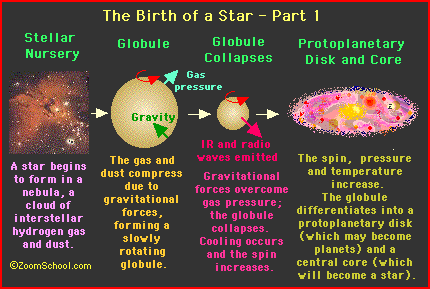

[HOME]
[WEB ALBUMS]
[PROJECTS]
[ARCHIVE]
[DOWNLOADS]
[LINKS]
PROJECTS
Project MK11: Masers; the OH molecule in star forming region W3(OH)
I got the opportunity to visit the Astropeiler observatory and do some measurements on the OH line.
After an impressive tour in the towering catacombs of the base, Wofgang Herrmann and I started first to check if the RTL dongle could resolve the OH line in the W3OH region at 1665.402MHz.
The RTL dongle was directly connected to the RF intermediate frequency output of 180.5MHz. With a windows machine and the cfrad2.exe program the next result was obtained.
The sample rate was set to 2.4MS/s giving 2.4MHz and via the cfrad2.exe sw there are 2048 bins of 1.2kHz each. Every line is the mean of 100000 spectra in 5 minutes. The bottom line is the average of the above 5 lines.
The W3 area is a nursing place of stars where clouds of all kind of gas and molucules are rotating around a more and more dense core.

Fig.1 - Starbirth phase1 (c)Zoomschool.com
From the top, the cloud it looks like this;

Fig.2 - Cloud top view
When there are OH molecules in that cloud, then they can begin masing when the molecules get exactly the right energy foton at the right distance from the centre of the cloud.

Fig.3 - Masing principle; the exited mulecule captures a foton and transmits 2 identical fotons etc.
When looking from the side to the cloud disk, the approaching cloud to us give a higher frequency signal, and at the other side of the centre the receding masing cloud gives us a lower frequncy (doppler).
Remarcable (and logical) is that, because of the higher mass of the OH molucule compared to the light hydrogen (H), the OH molucule does not generate a broad gauss velocity distribution.
 result1.png)
Fig.4 - top 5 lines; each 90s integration every 5 minutes, bottom line is sum
 result2.png)
Fig.5 - sum of 5*90s integration
 reference1.jpg)
Fig.6 - reference; mark the inverse x-axis
 region.jpg)
Fig.7 - W3(OH) region
 rotation.jpg)
Fig.8 - Speed calculations